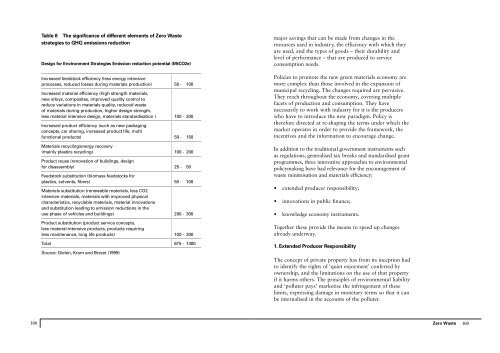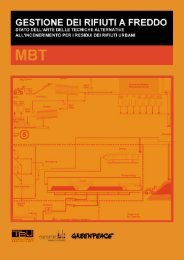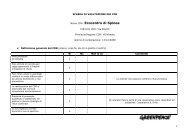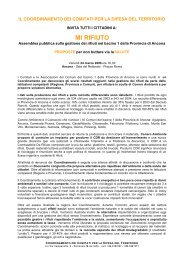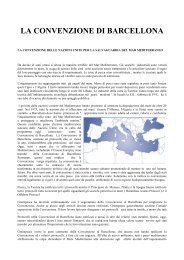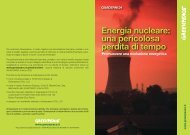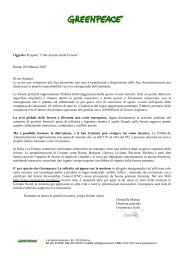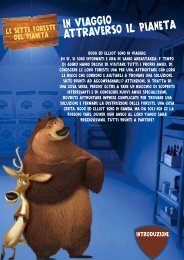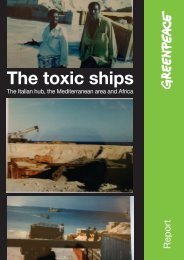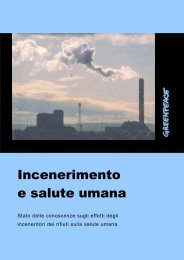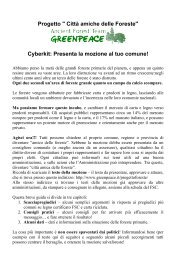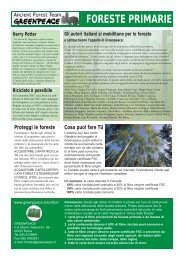Zero Waste by Robin Murray, Greenpeace Environmental Trust 2002
Zero Waste by Robin Murray, Greenpeace Environmental Trust 2002
Zero Waste by Robin Murray, Greenpeace Environmental Trust 2002
You also want an ePaper? Increase the reach of your titles
YUMPU automatically turns print PDFs into web optimized ePapers that Google loves.
Table 8 The significance of different elements of <strong>Zero</strong> Wa s t e<br />
strategies to GHG emissions reduction<br />
Design for Environment Strategies Emission reduction potential (MtCO2e)<br />
I n c reased feedstock efficiency (less energy intensive<br />
p rocesses, reduced losses during materials pro d u c t i o n ) 50 - 100<br />
I n c reased material efficiency (high strength materials,<br />
new alloys, composites, improved quality control to<br />
reduce variations in materials quality, reduced waste<br />
of materials during production, higher design strength,<br />
less material intensive design, materials standardisation ) 100 - 2 0 0<br />
I n c reased product efficiency (such as new packaging<br />
concepts, car sharing, increased product life, multi<br />
functional pro d u c t s ) 50 - 150<br />
Materials re c y c l i n g / e n e gy r re c o v e ry<br />
(mainly plastics re c y c l i n g ) 100 - 200<br />
P roduct reuse (renovation of buildings, design<br />
for disassembly) 25 - 50<br />
Feedstock substitution (biomass feedstocks for<br />
plastics, solvents, fibre s ) 50 - 100<br />
Materials substitution (renewable materials, less CO2<br />
intensive materials, materials with improved physical<br />
characteristics, recyclable materials, material innovations<br />
and substitution leading to emission reductions in the<br />
use phase of vehicles and buildings) 200 - 3 0 0<br />
P roduct substitution (product service concepts,<br />
less material-intensive products, products requiring<br />
less maintenance, long life pro d u c t s ) 100 - 2 0 0<br />
To t a l 675 - 1 3 0 0<br />
S o u rce: Gielen, Kram and Brezet (1999)<br />
major savings that can be made from changes in the<br />
resources used in industry, the efficiency with which they<br />
are used, and the types of goods – their durability and<br />
level of performance – that are produced to service<br />
consumption needs.<br />
Policies to promote the new green materials economy are<br />
more complex than those involved in the expansion of<br />
municipal recycling. The changes required are pervasive.<br />
They reach throughout the economy, covering multiple<br />
facets of production and consumption. They have<br />
necessarily to work with industry for it is the producers<br />
who have to introduce the new paradigm. Policy is<br />
therefore directed at re-shaping the terms under which the<br />
market operates in order to provide the framework, the<br />
incentives and the information to encourage change.<br />
In addition to the traditional government instruments such<br />
as regulations, generalised tax breaks and standardised grant<br />
p rogrammes, three innovative approaches to enviro n m e n t a l<br />
policymaking have had relevance for the encouragement of<br />
waste minimisation and materials efficiency:<br />
• extended producer responsibility;<br />
• innovations in public finance;<br />
• knowledge economy instruments.<br />
Together these provide the means to speed up changes<br />
already underway.<br />
1. Extended Producer Responsibility<br />
The concept of private property has from its inception had<br />
to identify the rights of ‘quiet enjoyment’ conferred <strong>by</strong><br />
ownership, and the limitations on the use of that property<br />
if it harms others. The principles of environmental liability<br />
and ‘polluter pays’ marketise the infringement of these<br />
limits, expressing damage in monetary terms so that it can<br />
be internalised in the accounts of the polluter.<br />
168<br />
<strong>Zero</strong> <strong>Waste</strong><br />
169


